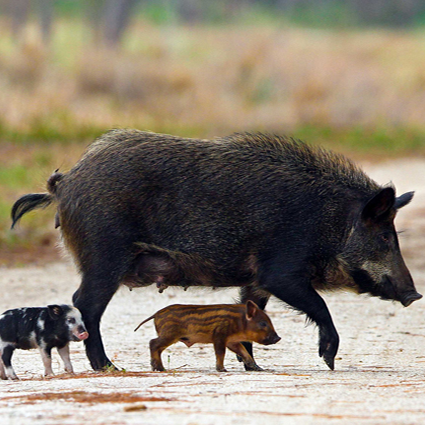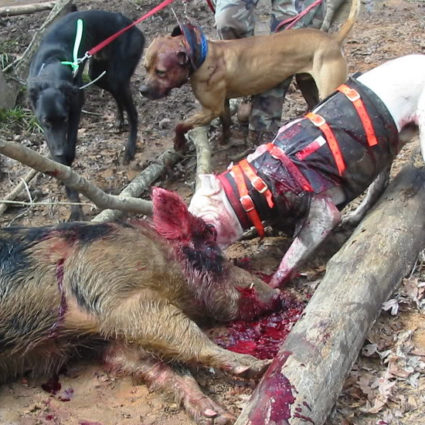The Wild Hog Problem
Simple put, America has a wild hog problem. It’s estimated that 2 to 3 million wild pigs are spread across 45 US States and the population is rapidly growing.
A female pig can breed at 4 months of age. She can have a litter of piglets 2 to 3 times each year. Each litter can produce between 6 to twenty piglets. This equates to 1 female producing sixteen to fifty pigs each year.
Man introduced pigs into the wild as a food source and because they are not native to the states, wild pigs have no natural predators, therefore it’s not possible to control populations via natural means.
Wild hogs can be compared to bulldozers with appetites. Pigs root (dig) through the dirt looking for food, destroying everything in it’s path. Wreaking havoc on farming lands, forests, natural wildlife habitats and gardens. They pollute water sources with fecal matter, can carry diseases, worms and even parasites.
Hogs are known to eat turkey, quail, pheasant, eggs, and to kill baby animals with their tusks. They have extremely sharp edges because the upper and lower tusks overlap. Needless to say this has become a huge problem in many states.
So what is being done about it?
Many states leave it largely up to residence, which is where inhumane practice of hog dogging comes into play.
You may not be familiar with the practice of hog dogging, let alone the history or what’s involved and how brutal this “sport” built on “tradition” actually is. The following articles help to educate and expose all of the above:


Hog-Dog Fighting Facts
Hog dog fighting stems from hog hunting, a still-legal pastime in which hunters use dogs to find, chase, corner, and sometimes catch the hogs. Because feral hogs are considered a nuisance in rural areas, locals still take pleasure in “taking down” a hog. Farmers charge that hogs trample native plants, create competition among other wildlife for food, and invade farmers’ crops. In many states, there are no limits on hunting, and hogs may be killed at any time of year, by any means.”
“When hunting feral hogs, dogs fall generally into two camps: “bay” dogs who only corner the hog, and “catch” dogs who actually clamp onto the feral hogs with their jaws. The latter dogs present a danger not only to the hog, but also to themselves, since the hog still has his powerful tusks. Traditional hog hunting first spurred “trials” in which dogs competed against each other to catch and corner hogs. Uncle Earl’s Hog Dog Trials in Winnfield, Louisiana, has been an annual event since 1995, and is now billed as the “Super Bowl of Hog Dog Baying.” There are even youth scholarships for the event.”
“While hog dog trials try to package themselves as respectable entertainment, they are often little more than glorified hog dog fights, similar to other blood-sports like dog-fighting, bullfighting, and cockfighting …”
Hunting Pigs With Dogs
“…Wild pigs are sometimes shot by “still” hunters waiting in a tree stand, but more common is the use of dogs to find, chase and attack pigs. Upon finding a pig, a dog pack will chase the animal until he or she is exhausted. Hunters follow on foot or in swamp buggies.”
““Breaking away from the dogs, the hog charged me. Piercing the hog with my spear, the spearhead broke off in the hog, the hog retreated to the bush. As I approached it again, it charged in a last attempt for its life. Once again I pierced the hog and held it off as it forced against the spear. As she weakened, I got a couple more stabs to finish her off.””
Description of a 2011 hunt, from the website of a Florida hunting guide
“Before the dogs are restrained, the pig can suffer horrible injuries. Sometimes, a wounded pig will escape, only to later die a lingering death.”
“Hunters crudely kill pigs with knives, as a firearm would endanger their dogs. Other unethical and inhumane weapons used to kill pigs include spears and swords!
Hunters will often castrate a young male pig, without anesthesia, before releasing him. The hunters believe that the animal will grow fatter and have better-tasting flesh when captured in the future.”
“Dogs can also be badly injured. On dog-hunting websites, hunters discuss how to dress wounds, deal with torn ears, lung punctures and what to do “if a dog gets gutted.”
Hog Wild Where Florida Hogs Cant Catch a Break
“… I had the opportunity to read a letter to the County Commissioner regarding the legality of the hunt. I’m not sure who the author is, but the following passage raises some interesting questions:”
“I urge the County Commission to reject the proposed hunts because the methods used are cruel to the pigs, often fatal to the dogs, and dangerous to the humans involved.”
“Section 828.12 of the Florida Statutes defines “animal cruelty.” It states that: A person who intentionally commits an act to any animal which results in the cruel death, or excessive or repeated infliction of unnecessary pain or suffering, is guilty of a third degree felony. Under this definition, It is a third degree felony to kick an animal. How is THIS hunt not? Is it because of necessity? Is it because we honestly NEED to kill hogs in this way? Or is it just a little more convenient than the alternatives?”
“You have just seen the video footage; this practice is the epitome of “unnecessary pain and suffering.” The dogs used do not just track the pigs; they are trained to attack them. Did you see the smiles on the hunters’ faces? Remember, people are paying to do this. This has nothing to do with necessity—this is a blood sport, with the consequence of lowering the hog population.”
“Remember the images: Packs of dogs tearing into a pig’s flesh, mutilating it and causing needless pain. This is to hold it in place while the human eventually catches up, and then proceeds to stab the pig repeatedly, trying to find its heart. And this is the BEST CASE scenario.”
“In the worst cases, the dogs themselves get gored, maimed, and killed in the struggle. Not to mention the danger of having humans in close-quarters knife combat with a wild animal.”
“Now, remember the language of the statute:
1) repeated infliction
2) unnecessary pain
3)cruel death
“To be clear, the Florida Statutes allow the NECESSARY killing of animals, and I understand that the hog population must be controlled. However, the method of killing must be humane, and this is anything but humane.”
“Even if this were the most effective way to kill wild pigs, pure effectiveness is not the end-all-be-all of any regulatory scheme. Two of you are attorneys; I know you understand this. I urge this Board to refuse to become accomplices to a practice that should be prosecuted as a felony. No, none of you is likely to be prosecuted, or even sued—qualified immunity takes care of that. But each of you is morally responsible for the consequences of your decision …”
